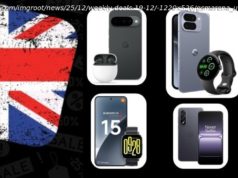My, has Google’s mobile operating system come a long way since Larry Page and Sergey Brin introduced the first Android phone, the T-Mobile G1.
In nearly a decade and a half covering the tech industry, I’ve had the privilege of witnessing companies go all out when showing off their new products. One of the more awkward is the image of Google co-founders Larry Page and Sergey Brin on Rollerblades gliding up to the stage to talk about the T-Mobile G1, the original Android phone.
From the over-the-top Samsung Galaxy Note 4 presentation at Radio City Music Hall in New York to David Blaine performing at the launch of the dual-screen Kyocera Echo (the magician’s tricks were far more memorable than the phone), companies have pulled stunts to nab your attention. But this odd moment is one that I can’t unsee.
The G1, unveiled 10 years ago on Sunday, marked the start of a phenomenon that now touches the lives of millions of people around the world. With more than 2 billion active Android devices today, and nine out of every 10 devices running the software, it’s a certifiable force in technology. It helped revolutionize what a modern smartphone could be, bringing the experience to the masses.
It all started with that launch.
„I remember so many cameras there,“ recalled Peter Chou, the then-CEO of HTC who took part in unveiling the G1. „I was kind of like, Wow; this is really, really big.“
Given its success today, it’s easy to forget that Android faced a heavy dose of skepticism at the start. The little-known operating system was taking on stalwarts Nokia, Windows Mobile and BlackBerry, and Apple’s iPhone had nabbed everyone’s attention. Looking back, the event now seems like a playbook on how not to launch a flagship phone.
When Google finally took the wraps off Android on Sept. 23,2008, it partnered with HTC, a little-known company that made smartphones carrying the brand names of other companies. The carrier partner was T-Mobile, half a decade before the Un-carrier campaign, when the company was still a struggling last-place national player. And back then, having an exclusivity deal with the right carrier mattered.
„It certainly seemed like there was an uphill battle,“ said Ross Rubin, an analyst at Reticle Research, who was also at the event.
So it was right about when Page and Brin rolled onto the stage that I started wondering where this was all going.
It was a brisk September morning in New York when I walked into the event, located in a studio space housed beneath the beginning of the double-decker Queensboro Bridge. It looked like any other product launch, with rows of chairs parked in front of a stage with a large monitor, only the morning traffic was zooming by above us.
The unusual venue was fitting for the launch of a new platform.
„It was clear we were on the cusp of something major,“ said Avi Greengart, an analyst at Global Data who attended the event.
The roots of Android can be traced back to a startup Andy Rubin founded in 2000 called Danger, which created the Sidekick, a cult favorite phone with a distinctive slide-out keyboard. In 2004, Rubin, who isn’t related to the analyst, left Danger for his follow-up act, a little company called Android. A year later, Google bought it for around $50 million.
Even before the acquisition, Rubin and HTC’s Chou were already working together to plot the next generation of smartphones.
„We discussed the vision of how we could make the mobile internet experience so much easier for mass-market consumers,“ Chou said.
Google and Rubin declined a request for an interview.
To get a sense of the power the carriers held, it was T-Mobile Chief Technology Officer Cole Brodman, not Rubin, who unveiled the G1.
Then Page and Brin skated up, having made their way across town on rollerblades (beats Manhattan traffic). Brin talked about the first app he wrote for the G1, a timer that starts when you throw the phone in the air. He then tossed it up.
„I was suggesting we don’t ship with that one,“ Page cracked.
Brin’s point was that the open operating system meant anyone could create apps and customize their phone experience.
„I’m a bit of a geek,“ he said. „I like tinkering with things.“
That ethos helped establish the dynamic between Android and Apple’s iOS in the early years. The iPhone was a tightly controlled experience designed for more users who just wanted something to work, while Android appealed to more tech-savvy tinkerers willing to customize their phones.
While Android eventually became a juggernaut, the G1 itself garnered mixed reviews. Many knocked the smartphone’s then-bulky design, though it looks positively tiny next to modern phablets like the Samsung Galaxy Note 9 or the iPhone XS Max. It also lacked things like pinch-to-zoom and email support for Exchange.
There was the slide-out keyboard, which mimicked the older Sidekick phone, but Android’s touch-friendly user interface rendered it less critical. There was also the awkward bottom „chin“ that bent at an angle and the physical trackball control.
„The G1 is definitely not the sleekest device, and we certainly wouldn’t call it sexy,“ said Bonnie Cha, who wrote the original CNET review . „Instead, the words ‚interesting‘ and ‚weird‘ come to mind.“
Still, most critics praised the Android software and the promise of future phones to come.
There was reason to be skeptical. Entrenched players like Nokia, Microsoft and BlackBerry (then known as Research in Motion) dominated the market for smartphones. Nokia, which wasn’t as popular in the US, had such a far lead around the world that few questioned its future.
While Google was already a powerhouse in search, its mobile chops were largely untested.
The G1 ultimately was a success for T-Mobile, but that didn’t necessarily mean everyone was clamoring for an Android phone. A strong launch at the No. 4 carrier in the US didn’t exactly equate to blockbuster success.
Also, not everyone wanted to tinker with their phone.
It wasn’t until a year later, when Google partnered with Verizon and Motorola to release the original Droid, which benefited from a $100 million marketing campaign, that Android hit the mainstream. That combined the marketing and retail might of Verizon, the know-how of Motorola and even a little Star Wars influence. (Verizon paid Lucasfilm for the right to use the Droid name.)
Ten years later, the smartphone landscape is dramatically different. Back then, white-collar workers or the tech savvy might have one. Today, you probably stare at your smartphone in the toilet.
Nine out of every 10 smartphones sold now run on Android. Apple generates the lion’s share of the industry’s profits by targeting high-end consumers. It’s a two-horse race.
„I’d be lying if I told you that I knew it would be powering 90 percent of the world’s smartphones,“ said Brodman, who now runs a wireless software startup called M87. „It’s literally changed the way the world connects.“
Microsoft’s Windows Mobile (later rebranded Windows Phone), the BlackBerry OS and Nokia’s Symbian software are gone, each player moving too slowly to reach the bar set by Apple and Google. Both companies leaned heavily on the idea of an app store, building up a lead in programs and developer support that other competitors couldn’t match.
There are still new BlackBerry and Nokia phones coming out — but they all run Android, and aren’t even built by the original companies.






